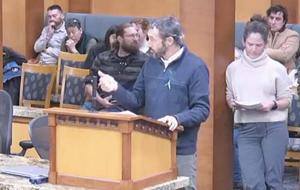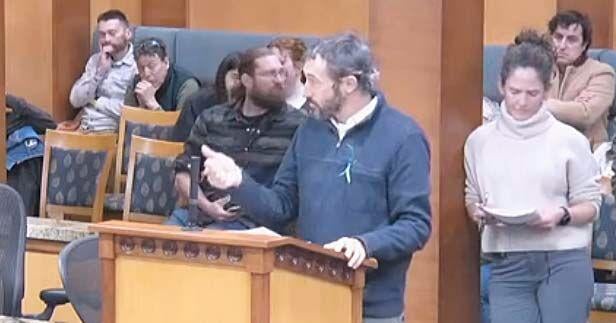
LOGAN – At their first meeting of the New Year, members of the Logan Municipal Council bowed to public pressure from a packed crowd of environmental idealists to reject buying into a natural gas power plant in Idaho.
The council voted 4-to-1 to turn thumbs down on Resolution 24-47, a proposal from the Logan Light & Power Department that would have committed the city to a 30-year, $284 million contract to purchase power from a new facility being constructed in Power County, ID.
Only council member Mark Anderson voted to support the resolution that would have guaranteed 30 mega-watts of baseload power for Logan’s residential and commercial customers starting in the 2030’s.
The council’s other members – chair Jeanne Simmonds, vice chair Mike Johnson, Amy Anderson and Ernest López – all cast votes that signaled their hope that some form of renewable energy will become available in the next decade to supply the city’s projected future power needs.
That vote was greeted with spontaneous applause from the partisan audience that was largely organized by Utah State University professor Patrick Belmont, who is also a member of the city’s Renewable Energy & Sustainability Advisory Board.
In December, council members approved a contract to participate in a natural gas fired power plant project in Millard County, over Belmont’s strenuous objections.
That contract committed city officials to a 25-year, $206 million contract that would satisfy the city’s projected peak power requirements of residents and businesses.
At the December meeting, Belmont expressed concern that Logan Light & Power Director Mark Montgomery had not brought the Millard County contract to the RESAB for review, insisting that its members would have rejected that proposal.
While acknowledging that renewable energy sources – like nuclear, geothermal and solar energy – are not yet fully reliable, Belmont argued that Logan needs to set a precedent of not planning to burn fossil fuels for another 20 to 30 years.
Belmont’s arguments and the aspirational comments of dozens of mostly young city residents during the early January public hearing struck a chord with council member López, who made the motion to reject the proposed resolution.
That motion was seconded by Johnson and, after some discussion, other council members fell into line.
Both Amy Anderson and Simmonds expressed concerns that obligating the city to the $284 million contract would restrict its ability to transition to renewable or alternative energy sources in the future, which might prove to be less expensive options in the long term.
During the debate, LL&P resource manager Yugi Zhao explained that three coal-fired and natural gas power plants currently providing 35 mega-watts of power to Logan are expected to go offline in the next decade.
Prior to their vote, Mark Anderson warned his fellow council members that wishful thinking about renewable energy sources won’t make up that power shortfall in the future.
If the council members are betting on the come for renewal energy sources, Mark Anderson suggested that they work with local lawmakers in the Utah Legislature to ensure that sources of energy like geo-thermal power remain in Utah after they are exploited, rather than being sold to the highest bidders in states like California, Oregon and Washington.

